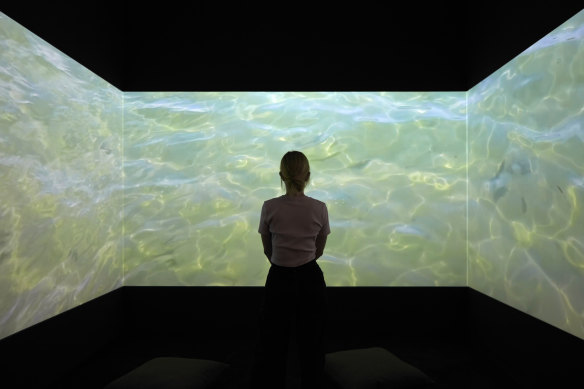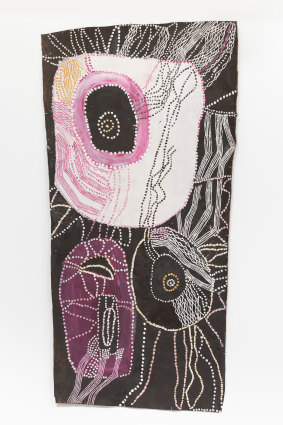Save articles for later
Add articles to your saved list and come back to them any time.
Yolngu country, in the gulf of Carpentaria, draws its identity from the everlasting rendezvous of salt water and fresh water. The same daily drama takes place in the Shoalhaven, in a vast estuary near Nowra. As with Yirrkala, where the Yolngu live, Bundanon, the property gifted to the nation by Arthur Boyd and his family, is an estuarine environment. This affinity is teased out in Miwatj Yolngu: Sunrise People, a stunning survey by a group of artists who have taken Australia by storm in recent years.
Bundanon director Rachel Kent developed close ties with this Indigenous community during her years as a senior curator at the Museum of Contemporary Art, and has been longing to do such a show. It’s hard to think of a more dynamic art centre than Buku at Yirrkala – a status reflected in the number of awards accumulated, the quantity of work acquired by public museums and leading private collectors, and the lineup of top commercial galleries eager to represent individual artists.
Maralitja (2021), by Gutinarra Yunupingu, at Bundanon’s Miwatj Yolngu: Sunrise People.Credit: Zan Wimberley
Central to the story is the vision of Djambawa Marawili, a senior lawman and an important artist in his own right, who has had to authorise each innovation. The Number One innovator has been Gunybi Ganambarr, who began by making conventional bark paintings and larrakitj poles, but soon ventured into a range of new materials: PVC piping, sheets of aluminium, discarded metal objects, insulation foil, rubber mats from a conveyor belt, chicken wire, and so on.
Whatever material may be found on country is fair game for Gunybi’s experiments, which have managed to stay true to traditional themes and motifs. Each of his breakthroughs has inspired other artists, resulting in a vast array of new forms. At the same time, the Mulka Project, a self-contained entity within the art centre, has encouraged artists to explore video and digital technology. Some brilliant work has been produced, which once again remains entirely within the bounds of community beliefs and protocols.
Finally, one needs to acknowledge the remarkable achievements of a group of women artists who did not begin painting until late in life. Foremost among them is Ms N. Marawili, who died a few weeks ago, and can only be spoken of in this slightly cryptic manner. There’s also Nyapanyapa Yunupingu and Mulkun Wirrpanda, who both who passed away in 2021; Djakanju Yunupingu, a rapidly rising star; and Dhambit Mununggurr, whose distinctive blue and grey bark paintings became instant collectors’ items.
Baratjala (2020), by Ms N. Marawili, earth pigments and recycled print toner on stringybark.Credit: Hassall/Milson Collection
Miwatj Yolngu: Sunrise People concentrates on these female painters in a display that would be jaw-dropping in any gallery, in any part of the world. Most of the works are drawn from private collections, with Geoff Hassell and Virginia Milson’s holdings being most prominent. The main gallery, which features works by Marawili and Nyapanyapa, is electrifying – almost literally, as many of the former’s paintings, notably those named Baratja, feature the motif of lightning striking a coastal rock. It’s a theme Marawili adopted so as not to trespass on any subjects she wasn’t ‘authorised’ to paint.
The word she used to describe these pictures is mayilimiriw, which translates as “meaningless”. We might prefer to say “abstract”, if this term wasn’t so loaded with art historical associations. In fact, Marawili’s lightning paintings, and her equally impressive grids that relate to fish traps, are organically connected to her everyday environment in a way that separates them from self-conscious western abstraction – the best example being Kandinsky’s work, currently showing at the Art Gallery of NSW.
The far wall of the main gallery is dominated by Nyapanyapa’s Ganyu (2020), a magnificent collection of pale ochre forms created with tiny, busy brushstrokes. This is another “meaningless” work that takes one’s breath away. The artist’s characteristic circles, with long, springy lines projecting on all sides, are at once suggestive of stars, of flowers, and even spiders. None of these superficial associations can account for Nyapanyapa’s uncanny sense of composition, in which so much of the painting is left in a pale, almost bare state, without ever seeming empty or unfinished.
Nyapanyapa’s ability to work on a large scale overshadows some of the smaller pieces in this show, such as the barks of Djirrirra Wunungmurra, carved with maddening, geometric precision, and painted with a predominantly white palette. Each of these fastidious pieces is a view of the cosmos.
It’s Dhambit’s work that has the most overtly spectacular presence. After being injured in a car accident and left unable to mix the traditional ochres, she was given permission to use paints from the tube. Her first choice was a dazzling blue that has becomes a kind of signature. Just as original as her choice of colours, Dhambit’s manner of painting has a spiky, aggressive edge, with figures waving claw-like hands like lobster men. In paintings such as Milpun milpun (2020) or Mangatharra (2021), they do battle with an overgrown turtle or octopus that might have sprung from a Japanese monster movie.
Ganyu (2020), by Nyapanyapa Yunupingu, natural earth pigments on board.Credit: Roslyn Oxley9 Gallery
Other parts of this exhibition feature engraved metal pieces by Wanapati Yunupingu and Gaypalani Wanambi, and audio-visual works by Ishmael Marika and Gutingarra Yunupingu.
Wanapati’s work uses tiny red diamond shapes against a bright, heavily worked surface to replicate the action of flames. Gaypalani’s trees look simple at first, but gradually we notice the artful way she has used the metal sheet, turning every hole or imperfection into part of the composition. The surprising power of both artists’ works comes from using a medium such as metal to connect so successfully with the natural world.
The audio-visual presentations are atmospheric pieces that create a sensory engagement with the tropical landscape. The exception is Gutingarra’s Gurrutu mi’ mala (My Connections) (2019), in which we see the artist, who is profoundly deaf, using Yolngu sign language.
One might speculate that Gutingarra’s deafness has enabled him to enjoy an unusually intense relationship with his surroundings. We see this heightened response to visual and sensory stimuli in his video Maralitja (2021), in which we feel the sea water rushing forward and surrounding us. It’s an ideal shared by many artists: to prompt the viewer to lose all sense of space and time, becoming immersed in the experience.
Miwatj Yolngu: Sunrise People is at Bundanon until February 11.
John McDonald stayed overnight, courtesy of Bundanon.
To read more from Spectrum, visit our page here.
Most Viewed in Culture
From our partners
Source: Read Full Article



